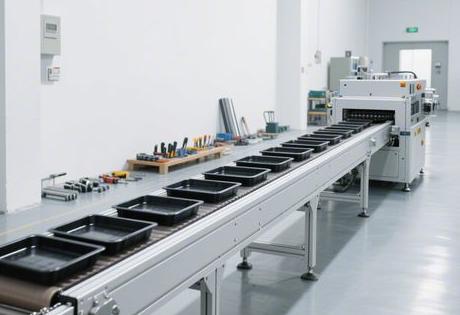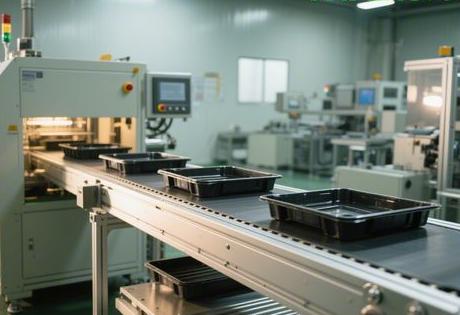I. Core technical principles: engineering realisation of differential speed effects
The central mystery of the triple-speed chainline is that theDesign of diameter difference between roller and roller(D/d=2), through the superposition effect of motion to achieve the "chain slow plate fast" speed increase effect. The physical principle can be expressed as follows:
Actual speed of the work plate V = V₁ × (1 + D/d)
When the roller diameter D is two times the roller diameter d, the theoretical speed can be up to three times the chain speed. However, three major contradictions need to be solved in actual engineering:

- friction loss: Traditional steel rollers have a coefficient of friction of 0.15, resulting in an actual speed increase of only 2.6-2.8 times
- Accumulation of heat distortion: 50 metres of line body temperature difference ± 5 ℃ can trigger 1.2 mm expansion, resulting in the risk of chain jamming
- Heavy duty slipping: Conventional chain slippage rate under 400kg load >8%
Innovative programmes::
- Composite Roller SetSilicon carbide ceramic layer (0.5mm thick) + micro-weave surface, wear resistance ↑400%, coefficient of friction down to 0.08
- Segmented temperature control rails: Embedded temperature sensors every 5 metres to dynamically adjust the PTFE expansion coefficient.
- Magnetic Fluid Tension ControlReal-time compensation for tension fluctuation, heavy load slippage rate <0.5%
Tesla Model Y production line in action::

- Door assembly beat is 90 seconds, shortening 40% compared with traditional production line.
- Mixed line production switchover time <10 minutes, supporting seamless transition from fuel/electric vehicles.
II. Key Components and Performance Breakthroughs: Synergistic Evolution of Precision Manufacturing
1. Technology upgrading of core components
assemblies Traditional programmes Triple Chain Programme performance enhancement sprockets Carburised steel (HRC58-62) Titanium honeycomb sandwich chain plate Flexural strength↑250% track roller engineering plastics Silicon Carbide Ceramic Composite Layer Lifespan of over 50,000 hours drive (vehicle wheel) Single Point Motor Distributed dual servo motors Torque fluctuation ↓80% locate Mechanical stopper Magnetic Levitation Blocker Response time ≤10ms 2. Intelligent control system architecture
plaintextmake a copy ofSensing layer: ▪ Laser ranging array (±0.03mm positioning) ▪ Infrared thermal camera (±0.5°C temperature monitoring) Decision layer: ▪ Digital twin preview of load changes → dynamic adjustment of inverter outputs Execution layer: ▪ Servo jacking machine (synchronisation accuracy ±0.1°) ▪ RFID tooling board (real-time transmission of process parameters)Ningde Times battery production line case: 450kg battery package matching accuracy ±0.05mm, yield increased to 99.2%
3. Revolutionary optimisation of energy efficiency
- Power density jumpsFlat wire motor technology enables power densities of up to 8kW/kg (compared to 3.5kW/kg traditionally) and a reduction in the size of the drive unit by 40%.
- kinetic energy recovery system: Deceleration section power feedback to the grid, integrated energy consumption down 18%
- Self-healing lubricationMicroencapsulated lubricant with 50μm repair particles for extended maintenance intervals of up to 5000 hours.
III. Industry application scenarios: empirical evidence of efficiency reconstruction
1. Automobile manufacturing (COMAC C919 assembly line)
- 1.2 tonne engine parts conveyor with ±0.05mm positioning accuracy
- Constant temperature clean environment (temperature fluctuation ≤ ± 0.3 ℃), zero assembly error rate
2. 3C electronics (Apple AirPods production line)
- Static dissipative chain (surface resistance 10^6-10^9Ω), suitable for class 10,000 cleanliness.
- Sorting peak efficiency 24,000 pieces/hour, error rate <0.01%
3. Intelligent warehousing (Jingdong Asia Warehouse No. 1)
- S-shaped sorting line layout compression 40% space, 3000 square metres to achieve 5000 square metres capacity
- Digital twin system dynamic traffic diversion, congestion prediction accuracy 99.3%
IV. Future trends: from mechanical drives to quantum synergies
1. Superconducting magnetic levitation drives (mass production in 2026)

- Liquid Nitrogen Cooled Superconducting Coil Replaces Mechanical Roller, Theoretical Growth Rate Ratio Breaks Through6 times
- Zero-contact drive eliminates metal dust and meets chip-level cleanliness requirements.
2. Piezoelectric smart materials
- MIT developed piezoelectric rollers: real-time sensing of load deformation (sensitivity 0.1μm), self-adjusting friction coefficient (0.05~0.25)
3. Quantum edge computing
- 100,000 nodes conveyor network scheduling response delay <5ms (traditional PLC needs 200ms), thermal deformation compensation error ≤0.01mm
Self-questioning: core concerns of triple-speed chain lines
Q1: Is the tripling rate a real growth rate or a theoretical one?
A.Measured growth rate range of 2.8-3.2 timesThe design of the product is influenced by the load and the operating conditions:
- Light load (≤200kg): 3.0-3.2 times measured (friction loss 5%)
- Heavy load (≥800kg): 2.8-3.0 times with hydraulic compensation enabled
Q2: Why don't you increase the roller diameter infinitely?
A.Subject to geometric constraints and dynamics::
- Maximum roller diameter ≤ chain pitch × 0.85 (anti-interference)
- Centrifugal force offset >0.1mm when D/d >2.5, affecting positioning accuracy
Q3: Is the maintenance cost higher than traditional conveyor lines?
A.Full Life Cycle Costs Reverse 28%::
- Self-healing lubrication system extends maintenance intervals to 3 years
- AI Predictive Maintenance Reduces Sudden 70% Failures
While the global manufacturing industry is chasing "drones", the triple-speed chain line is taking the lead with theAccuracy of ±0.05mm under 1.2 tonnes of heavy loads, andReduced energy consumption of 50 metre line body 34%The hardcore data proves it.The essence of the efficiency revolution is the precise balance between physical limits and intelligent control of the basic drive components..













